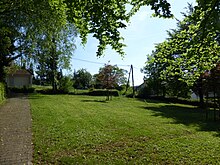Shear lawn
Shear lawns or ornamental lawns are regularly mowed lawns in populated areas or on sports fields. Due to the frequent cutting, the vegetation resembles that of fat willow .
distribution
Shear lawns are common in cities, villages, and roadsides around the world.
Vegetation position of the shear lawn
The vegetation of the German Scherrasen was described by Hülbusch & Kienast and von Gutte as an independent plant community . By both authors, the ornamental lawn companies are the Association assigned Cynosurion.
Typical shear grass communities of dry, nutrient-poor locations are the Bellido perennis-Festucetum brevipilae with callous dandelions such as Taraxacum tortilobum and the Crepido capillaris-Festucetum rubrae, very rarely even with orchid species such as Ophrys apifera (subassociation ophrietosum). Old park lawns are usually characterized by a pronounced layer of moss and a number of typical species such as the small brown fish ( Prunella vulgaris ), Quendel speedwell ( Veronica serpyllifolia ), germander speedwell ( Veronica chamaedrys ). In much-trodden areas there are often transitions to step turf societies . Extensively manicured lawns on sandy soils can approach dry grass communities in the species combination. Moist locations, rarely even with creeping celery ( Helosciadium repens ), convey the turf .
Species composition
flora
Distinguishing plant species of ornamental lawns are, for example, Achillea millefolium , Bellis perennis , Cerastium holosteoides , Crepis capillaris , cocksfoot ( Dactylis glomerata ), Festuca ovina ( Festuca ovina ), perennial ryegrass ( Lolium perenne ), Kentucky bluegrass ( Poa pratensis ), and Common bluegrass ( Poa trivialis ), different types of dandelion ( Taraxacum spec.), White clover ( Trifolium repens ).
fauna
As a result of intensive use / maintenance, habitats that are usually very poor in species, in which mainly some ground-dwelling insects - such as As various running - / rove beetles - Erdeulen - and grasshopper species - occur. On historical grassland locations, these biotopes can have high development potential, so that they become richer in species worthy of protection if they are significantly expanded in terms of use or care.
Importance for species protection
Despite the high frequency of cuts, shear lawns are often rich in species. They can also be a habitat for endangered plant and animal species. The regular removal of biomass with the cut often creates poor locations without fertilization, which allow the occurrence of low-growing species of the grasslands. Moist shear lawns are the habitat of the FFH species Helosciadium repens . Especially when caring for species-rich, old and poor park lawns, herbicides, extensive overseeding and intensive fertilization should be avoided.
literature
- Heiko Himmler: Ornamental lawns in the South Palatinate as locations for rare plant species. In: Pollichia Kurier. Volume 18, No. 3, 2002, pp. 14-17.
- Erich Oberdorfer: South German plant communities Part III - Farm meadows and weed communities. 3rd edition, Jena, Stuttgart, New York 1993.
- Richard Pott: The plant communities in Germany. Ulmer, Stuttgart 1995, ISBN 3-8252-8067-5
Web links
- Creeping celery (Apium repens) species in Annex IV of the Habitats Directive. BfN Federal Agency for Nature Conservation.
Individual evidence
- ↑ Festuco-Crepidetum capillaris Hülbusch & Kienast 1978, D. Kienast: The spontaneous vegetation of the city of Kassel as a function of the building and urban structure of the district. In: Urbs et Regio. Volume 10, Kassel 1978.
- ↑ Bellidetum perennis Gutte 1984, Peter Gutte: The vegetation of Leipzig lawns. In: Gleditschia. Volume 11, 1984, pp. 179-197.
- ↑ Steffen Hammel: Ophrys apifera HUDS. in shear lawns of the Cynosurion Tx. 47 association. In: Journal of European Orchids Volume 40, No. 1, 2008, pp. 3–23.
- ↑ a b O. Stöhr, S. Gewolf & Ch. Niederbichler: Apium repens (Jacq.) Lag. In Scherrasen - an FFH species on the wrong track? In: Reports of the Bavarian Botanical Society Volume 73/74, 2004, pp. 67–84.
- ↑ Hanna Köstler, Christian Grabowski, Manfred Moeck, Christoph Saure & Karl-Hinrich Kielhorn: Description of the biotope types on the basis of the list of biotope types in Brandenburg (as of 2004) and the explanatory texts (as of 1994) by Dr. Frank Zimmermann (Brandenburg State Environment Agency), 2005.


